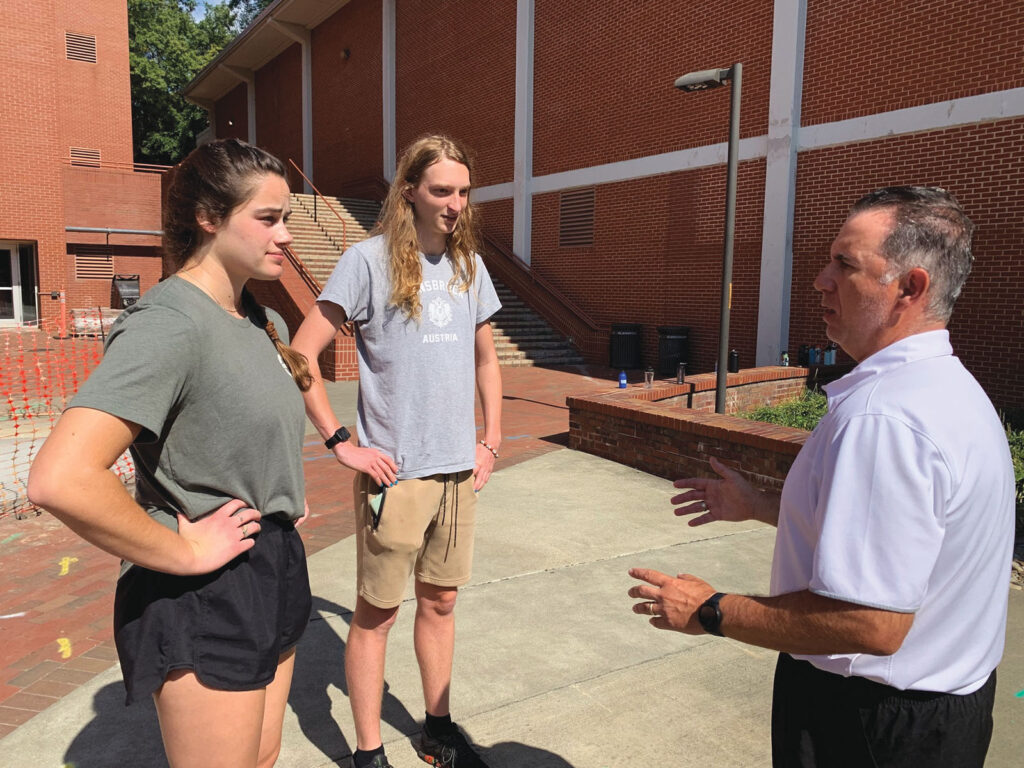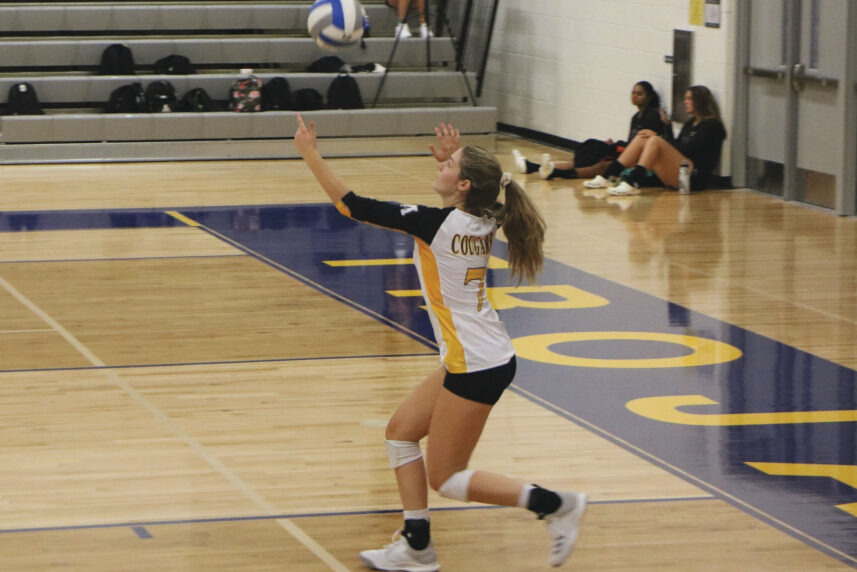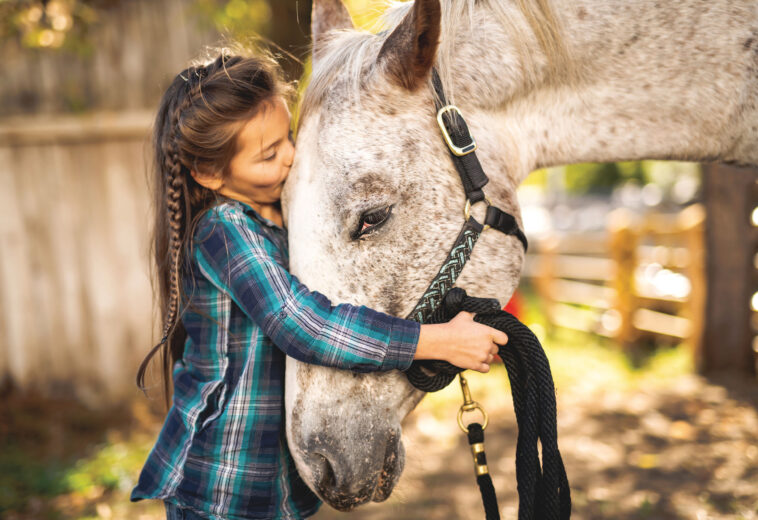Article:
Cardio and Classes
College students earn a range of benefits from school exercise programs
BY KURT DUSTERBERG
When Katie Shugg went off to college at Virginia Tech in August 2020, she packed away plenty of fond memories from her teen years, playing on high-level club volleyball teams and earning all-conference honors at Apex High School. But without the routine of games and practices, she noticed some changes. “When I started college, I didn’t realize I would need to continue to work out in order to stay fit,” she says. “I started to notice my body changing, and I was going to parties and studying a lot more, so I was moving a lot less. I also wasn’t walking to class much, because most of my classes were online [due to COVID].”
The computational modeling and data analytics major quickly decided to get back to her active ways. “Our campus has a really nice gym, and I started using various machines like treadmills, the stairmaster, ellipticals and yoga mats,” she says. “Now, I go to the gym almost every weekday.”
Many college students face the same issue, forming new routines in new environments. But there is more at stake than just gaining the “freshman 15.” Maintaining a level of fitness into the adult years helps sustain the active habits of childhood and manage the stress associated with the academic challenges of college and the onset of adult responsibilities.
A 2023 study from Oregon State University found that 32% of U.S. colleges and universities require some form of physical education course to graduate, down from 39% as observed in a similar study from 2010. The recent study found that 56.2% of institutions did not require physical education, while 12.1% had a partial requirement.
North Carolina State University takes the role of physical health seriously, requiring graduates to earn two credits in the Department of Health and Exercise Studies. A wide variety of offerings such as fitness walking, kickboxing and swim conditioning give students the chance to find an activity that works for them.
“You’re talking about both kids who have been competitive in high school and students who only took that one required class in PE back in ninth grade,” says Peter Koutroumpis, an instructor in the department. “So you’ve got the competitive athletes who know they want to stay active. You’re also talking about those who weren’t active in high school at all, or who might have gotten injured when they were younger and stopped competitive sports.”

WORKING FITNESS IN
On a warm fall afternoon, Koutroumpis has his fitness walking class ready to move out. The students are dressed in shorts and T-shirts, and most of them seem purposeful as they head outside for a 2-mile walk that will be followed by 30 pushups, 30 crunches and 30 squats.
Shay Parton, a junior from Rutherford County, has used the fitness walking classes to rekindle the athleticism she relied on as a varsity athlete in high school. “I have loved this class so far,” she says. “The amount of time we’re walking has been almost an opening back to my soccer days, because we’re working on cardio and muscle endurance.”
Some students enroll in the 100-level courses just to check a box to meet the credit requirements. That’s what Luke Jackson thought when he signed up for fitness walking, but the junior transfer from Johnston Community College quickly had a change of heart.
“I did cross country in high school and I’ve been doing it sort of on-and-off on my own, but it’s hard to keep it up,” Jackson says. “So if I’m going to show up here, I should take it seriously. It’s another way of exercising to get your cardio in. That’s why I like this; it’s sort of lower stress.”
The benefits of physical activity on campus go beyond maintaining a level of fitness, a lesson that is reinforced in the classroom. Students learn that the stress response affects them psychologically, physiologically and hormonally. “Academic rigor at the collegiate level is high,” Koutroumpis says. “A lot of the students don’t have the ability to manage those aspects of their life if they’re not being paid attention to. And all the research backs it up—it’s not just talk. A little bit of movement and activity makes a difference … The benefits are a stronger, more efficient heart rate, cardio-respiratory endurance and muscle endurance. They’re all things that are needed to manage and combat stress levels and combat cardiovascular disease and illnesses.”
Parton acknowledges that the exercise class helps her deal with the demands of her academic life. “It has made things a lot more manageable,” she says. “Something that seems so simple, like doing the 30–30–30s after a mile or
2 miles of very fast walking, can still be so difficult. It’s nice to know that I can apply that into my everyday life. If I’m studying and know I need to get my heart beating faster, I can apply those things.”
Beyond the preliminary classes are a wide variety of sports and exercise options, such as rock climbing, tennis, racquetball and weight training. Students are expected to build on the basic competencies of a sport, even if they have some experience in the activity from their childhood. “Just because they played soccer doesn’t mean they can take 10 penalty kicks and hit the goal on all of them,” Koutroumpis says.

LEVELING THE PLAYING FIELD
The benefits of the program go beyond the physical and psychological. Pairing up random undergrads in a different setting can forge new relationships. “You could have someone who was a varsity baseball player in high school and someone else who was part of the band,” he says. “They’re starting from zero with each other. Physical activity brings everybody to the base core of who they are, no matter what they look like doing the activity. Everybody is doing it together. That’s a big part of it.”
And a little bit of self-confidence is an added bonus. “They’re pushing themselves to a level they probably wouldn’t otherwise,” Koutroumpis says. “From there, it gets them to be more introspective with themselves: I can do this. I got through it and it wasn’t as bad as I thought.”


